Alcohol is a psychoactive substance made from ethanol, commonly used for recreational, cultural, medicinal, and industrial purposes. Found in drinks like beer, wine, cider, spirits, and liqueurs, its effects range from relaxation and euphoria to impaired judgment and reduced coordination.
While used socially, alcohol acts on the central nervous system, leading to intoxication and, over time, physical dependence. Long-term use increases the risk of liver damage, heart disease, cognitive decline, and mental health issues like depression and anxiety.
According to the NCDAS, Pennsylvania averages 5,703 alcohol-related deaths each year, showing the serious impact of misuse. Risk factors include genetics, mental health, and drinking habits, all of which raise the chance of addiction, withdrawal, and alcohol-related harm.
What Is the Definition of Alcohol?
Alcohol is a class of organic compounds characterized by one or more hydroxyl (-OH) groups attached to a carbon atom of an alkyl group. These compounds are viewed as derivatives of water, where an alkyl group replaces a hydrogen atom. Common examples of alcohol include ethanol, methanol, and isopropyl alcohol.
Alcohol consumption statistics in Pennsylvania by Addiction Group.org, data from 2015 to 2019, indicate that alcohol-related deaths outnumber drug overdose fatalities, with over 5,700 annual alcohol-related deaths reported during this period.
Why Do People Drink Alcohol?
People drink alcohol because of social, cultural influences, and personal coping mechanisms. Both positive and negative motivations shape drinking habits.
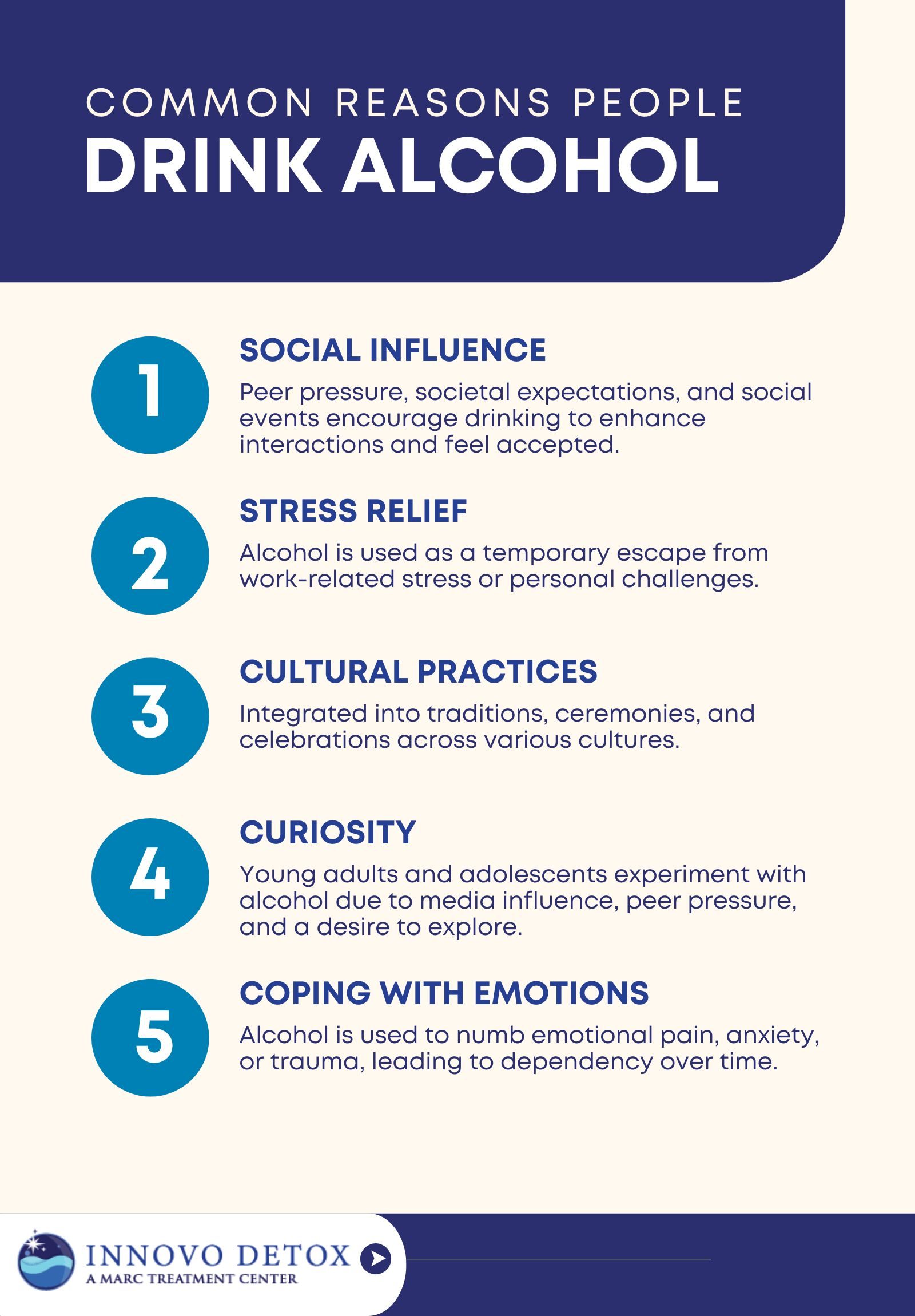
Reasons people drink alcohol include:
- Social Influence: Peer pressure, social gatherings, and societal expectations encourage alcohol consumption. Many people drink to feel accepted in social circles, enhance interactions, or bond with friends and colleagues. Alcohol is commonly associated with parties, celebrations, and networking events, making it a socially reinforced habit.
- Stress Relief: Alcohol is sometimes used as a means to relax and unwind after a long day. Some individuals turn to drinking as a quick escape from life’s pressures, work-related stress, or personal challenges, even though it provides only temporary relief and leads to dependency over time.
- Cultural Practices: Alcohol plays a significant role in traditions, religious ceremonies, and family gatherings in many cultures. Some societies integrate drinking into rites of passage, weddings, or festivals, where alcohol symbolizes celebration, hospitality, or even spirituality.
- Curiosity: People, especially young adults and adolescents, experiment with alcohol due to curiosity or a desire to fit in. The appeal of trying something new, combined with media portrayals and peer influence, drives individuals to consume alcohol without fully understanding its effects.
- Coping with Emotions: Some individuals use alcohol as a way to numb emotional pain, loneliness, anxiety, or trauma. It serves as a temporary escape from negative feelings, but over time, reliance on alcohol for emotional regulation contributes to addiction and worsens mental health struggles.
What Are the Types of Alcoholic Beverages?
The types of alcoholic beverages include beer, wine, cider, spirits, fortified wines, liqueurs, and sake. These types are diverse, each with unique characteristics and cultural significance.
The types of alcoholic beverages are as follows:
- Beer: A fermented beverage made from grains like barley, hops, yeast, and water. Beer contains 3-5% alcohol by volume (ABV) and is popular due to its wide range of flavors and social acceptance. In Pennsylvania, beer is the most consumed alcoholic beverage, reflecting national trends. Moderate consumption leads to relaxation, but excessive intake impairs judgment and coordination.
- Wine: Produced by fermenting grapes or other fruits, wine usually has an ABV of 12 to 15%. It’s associated with cultural and religious ceremonies. In Pennsylvania, wine consumption has steadily increased, with a notable rise in local winery establishments. While moderate wine consumption has been linked to certain health benefits, overconsumption leads to various health issues.
- Cider: Made from fermented apple juice, cider’s ABV ranges from 4 to 6%. It’s favored for its sweet taste and is especially popular during autumn in Pennsylvania, aligning with the state’s apple harvest season. Cider’s lower alcohol content makes it a casual beverage, but excessive consumption still poses health risks.
- Spirits (e.g., Vodka, Gin, Rum, Tequila, Whiskey, Brandy): Distilled beverages with a higher ABV, around 40%. Spirits are versatile and used in various cocktails. In Pennsylvania, spirits have seen a surge in popularity, with whiskey being a top choice among consumers. Due to their high alcohol content, spirits lead to quicker intoxication and should be consumed responsibly.
- Fortified Wine (e.g., Port, Sherry): Wines to which a distilled spirit, usually brandy, is added, increasing the ABV to 15 to 20%. These are enjoyed as dessert wines. While not as commonly consumed as other beverages in Pennsylvania, they hold a niche market. Their higher sugar and alcohol content necessitates mindful consumption.
- Liqueurs (e.g., Amaretto, Baileys): Sweetened spirits infused with flavors like fruits, herbs, or nuts, with an ABV of 15 to 30%. Used in cocktails or as after-dinner drinks. In Pennsylvania, liqueurs are popular during holidays and special occasions. Their sweetness masks the alcohol content, leading to overconsumption if not monitored.
- Sake: A Japanese alcoholic beverage made from fermented rice with an ABV of 15 to 20%. While traditionally consumed warm, it’s also enjoyed chilled. Sake is growing in Pennsylvania, especially in Japanese restaurants and cultural festivals. As with other alcoholic beverages, moderation is key to preventing adverse effects.
What Are the Types of Drinkers?
The types of drinkers are categorized based on their drinking patterns and the impact alcohol has on their lives. These classifications help understand different drinking behaviors, but individual drinking patterns vary widely.
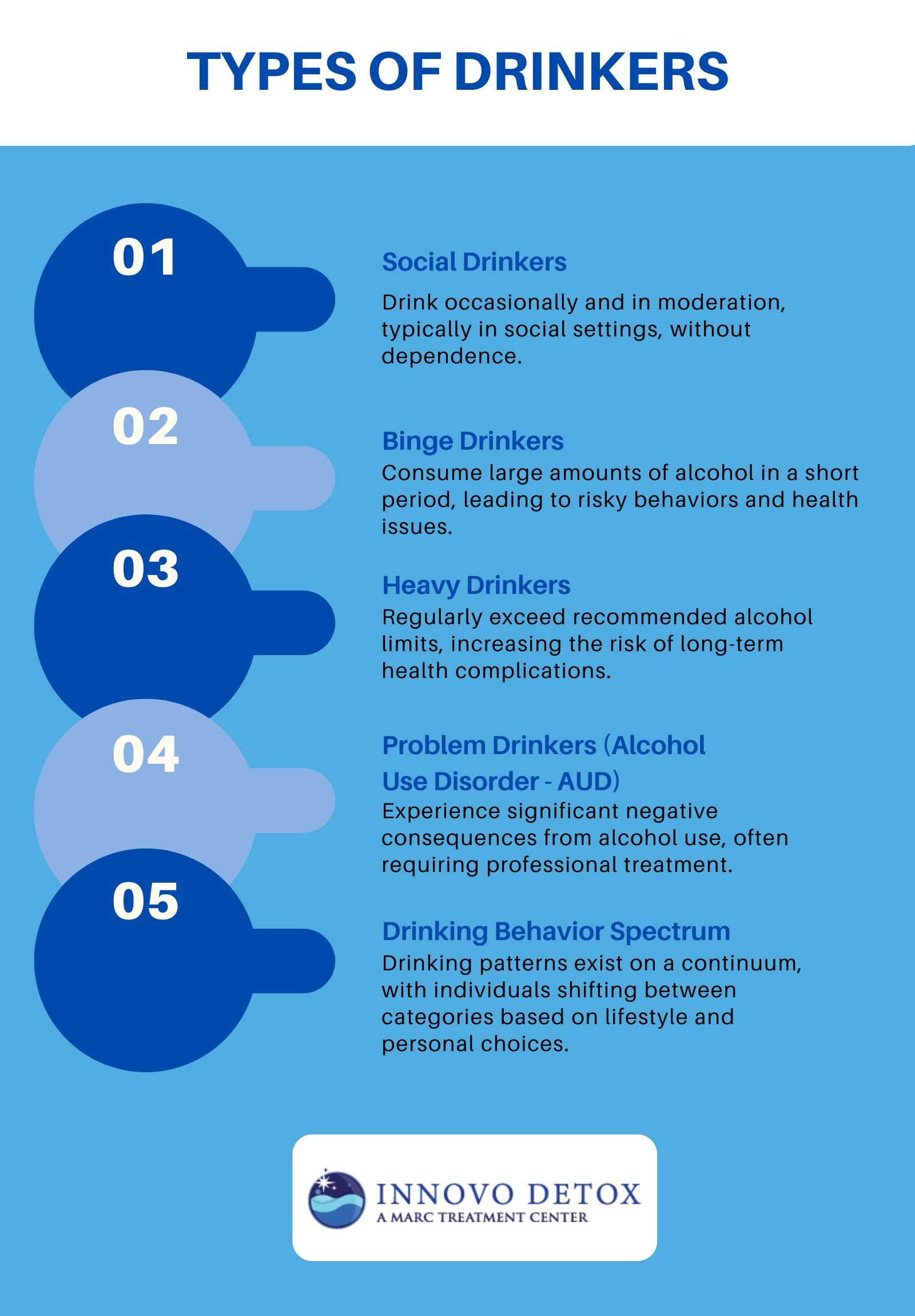
Types of drinkers include:
- Social Drinkers: Social drinkers consume alcohol occasionally and in moderation, typically in social settings. They do not rely on alcohol for emotional relief, nor do they experience negative consequences or develop dependence. Their drinking habits remain within safe limits without interfering with daily life.
- Binge Drinkers: Binge drinkers consume large amounts of alcohol in a short period, leading to dangerously high blood alcohol levels. This drinking pattern increases the risk of accidents, alcohol poisoning, and long-term health complications. While not necessarily dependent on alcohol, binge drinking leads to risky behaviors and negative health outcomes.
- Heavy Drinkers: Heavy drinkers frequently consume alcohol in high quantities, consistently exceeding recommended limits. This behavior puts them at a higher risk of developing severe health problems such as liver disease, cardiovascular issues, and addiction. Regular heavy drinking gradually leads to alcohol dependence and significant lifestyle disruptions.
- Problem Drinkers (Alcohol Use Disorder – AUD): Problem drinkers, or those diagnosed with Alcohol Use Disorder (AUD), experience major negative consequences due to their drinking. Their alcohol use impairs relationships, work performance, and physical and mental health. They struggle to control their intake and require professional treatment to manage their drinking habits.
- Drinking Behavior Spectrum: These categories represent a general framework, but drinking behaviors exist on a spectrum. Individuals shift between these classifications over time based on lifestyle changes, stress levels, or personal choices. Recognizing these distinctions helps identify risky drinking patterns and encourages healthier decisions.
What Are the Effects of Drinking Alcohol?
The effects of drinking alcohol are both immediate and long-term, impacting physical and mental health in significant ways. The consequences vary depending on individual tolerance, frequency of use, and the amount consumed.
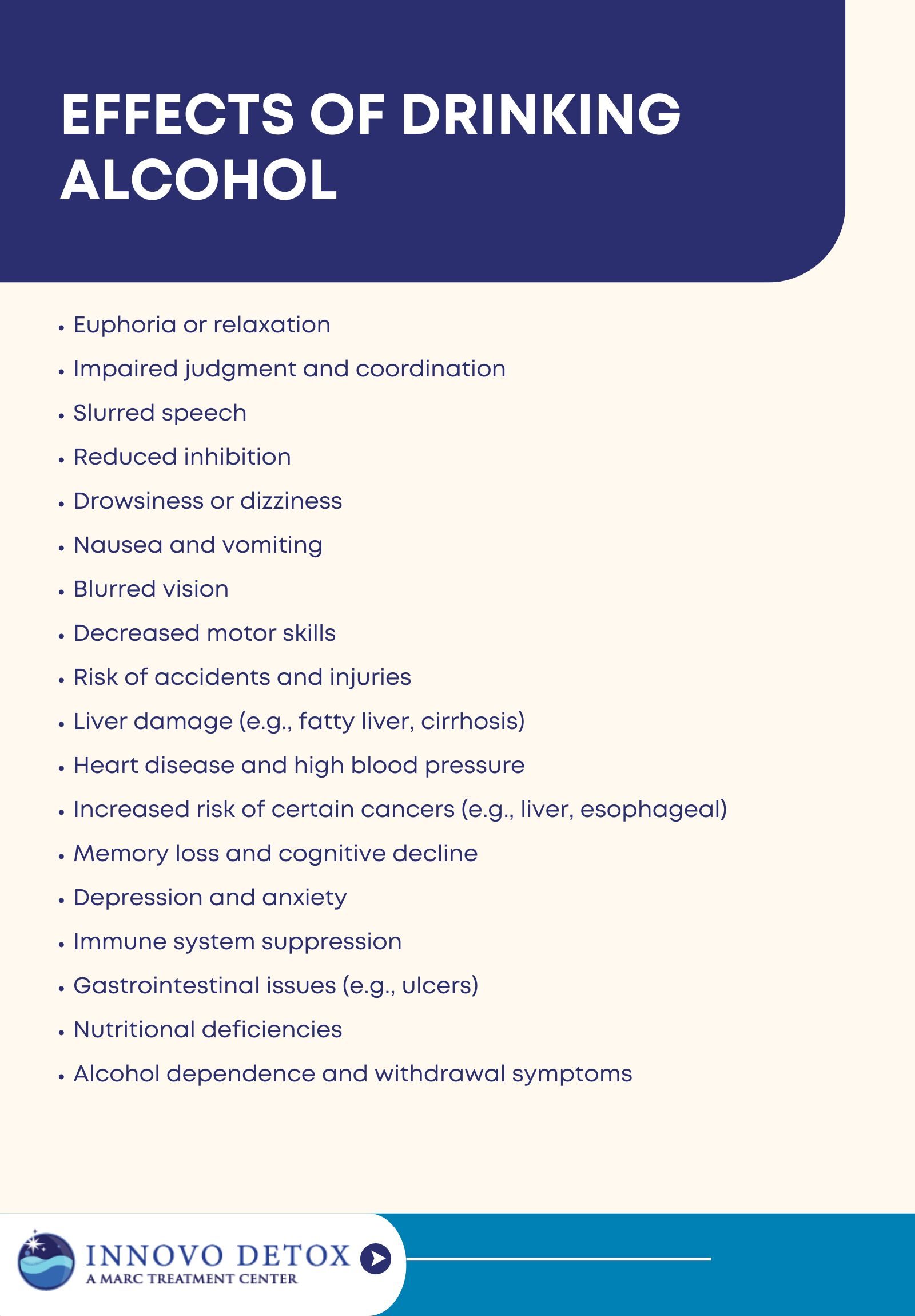
The effects of drinking alcohol include:
- Euphoria or relaxation: Alcohol creates a sense of pleasure, reduces stress, and provides temporary relief from anxiety.
- Impaired judgment and coordination: Even small amounts of alcohol slow reaction times and impair decision-making. This immediate effect increases the likelihood of accidents, risky behaviors, and poor choices that have long-term consequences.
- Slurred speech: Alcohol disrupts the brain’s ability to control muscle movement, leading to slurred or incoherent speech. This short-term effect is an early sign of intoxication.
- Reduced inhibition: Alcohol lowers self-control by depressing activity in the prefrontal cortex. While this promotes socialization, it also increases the likelihood of engaging in risky behaviors such as unsafe sex, reckless driving, or aggressive actions.
- Drowsiness or dizziness: Alcohol’s depressant effects on the central nervous system cause drowsiness, fatigue, or dizziness, which result in difficulty staying alert and an increased risk of falls or accidents, according to a study by Pervin Z, Stephen JM. et al. 2021, titled “Effect of alcohol on the central nervous system to develop neurological disorder: pathophysiological and lifestyle modulation potential therapeutic options for alcohol-induced neurotoxication.”
- Nausea and vomiting: Excessive alcohol consumption irritates the stomach lining and disrupts digestive processes, leading to nausea and vomiting. This short-term effect is a protective response from the body to prevent further intoxication.
- Blurred vision: Alcohol impairs the brain’s ability to process visual information, leading to temporary blurred or double vision. This makes tasks like driving or walking more dangerous.
- Decreased motor skills: Alcohol affects coordination and muscle control, making simple movements more difficult. This impairment increases the risk of falls, injuries, and accidents. About 30% of alcoholics develop Wernicke-Korsakoff syndrome, a severe brain disorder linked to alcohol use, which affects memory and cognitive abilities.
- Risk of accidents and injuries: Due to its impact on judgment, coordination, and motor skills, alcohol consumption is a major contributor to accidents, including car crashes, falls, and workplace injuries. These risks increase with higher levels of intoxication.
- Liver damage (e.g., fatty liver, cirrhosis): Chronic alcohol use leads to liver disease, including fatty liver, hepatitis, and cirrhosis. Over time, excessive drinking causes irreversible liver damage, impairing the body’s ability to process toxins. More than 90% of people who drink excessively experience liver damage. Around 10 to 35% develop inflammation, known as alcoholic hepatitis. About 10 to 20% of heavy drinkers progress to cirrhosis, a more severe form of liver damage.
- Heart disease and high blood pressure: Long-term alcohol consumption contributes to high blood pressure, irregular heartbeats, and an increased risk of heart disease, including cardiomyopathy and stroke.
- Increased risk of certain cancers (e.g., liver, esophageal): Alcohol is classified as a carcinogen and has been linked to an increased risk of cancers of the liver, esophagus, breast, and mouth. The risk rises with prolonged and excessive consumption.
- Memory loss and cognitive decline: Alcohol affects brain function, leading to short-term memory lapses (blackouts) and, over time, an increased risk of dementia and cognitive impairment. Chronic alcohol use causes structural damage to the brain.
- Depression and anxiety: While alcohol temporarily relieves stress, it disrupts brain chemistry and worsens mental health conditions like depression and anxiety. Chronic drinking is associated with a higher risk of mood disorders.
- Immune system suppression: Excessive alcohol weakens the immune system, making the body more susceptible to infections such as pneumonia and tuberculosis. Long-term use impairs the body’s ability to fight disease..
- Gastrointestinal issues (e.g., ulcers): Alcohol irritates the digestive tract, increasing the risk of ulcers, acid reflux, and inflammation of the stomach lining (gastritis). Long-term use also leads to pancreatic damage.
- Nutritional deficiencies: Alcohol interferes with the body’s ability to absorb essential vitamins and minerals, leading to deficiencies in nutrients like vitamin B1 (thiamine), which cause neurological disorders such as Wernicke-Korsakoff syndrome.
- Alcohol dependence and withdrawal symptoms: Chronic alcohol use leads to physical and psychological dependence, making it difficult to stop drinking. Withdrawal symptoms, such as tremors, seizures, anxiety, and hallucinations, are severe and require medical intervention.
What Are the Risks of Alcohol Use?
The risks of alcohol use are chronic diseases, engaging in dangerous behaviors, and experiencing long-term cognitive decline. Understanding these risks is important for making informed decisions about alcohol consumption.
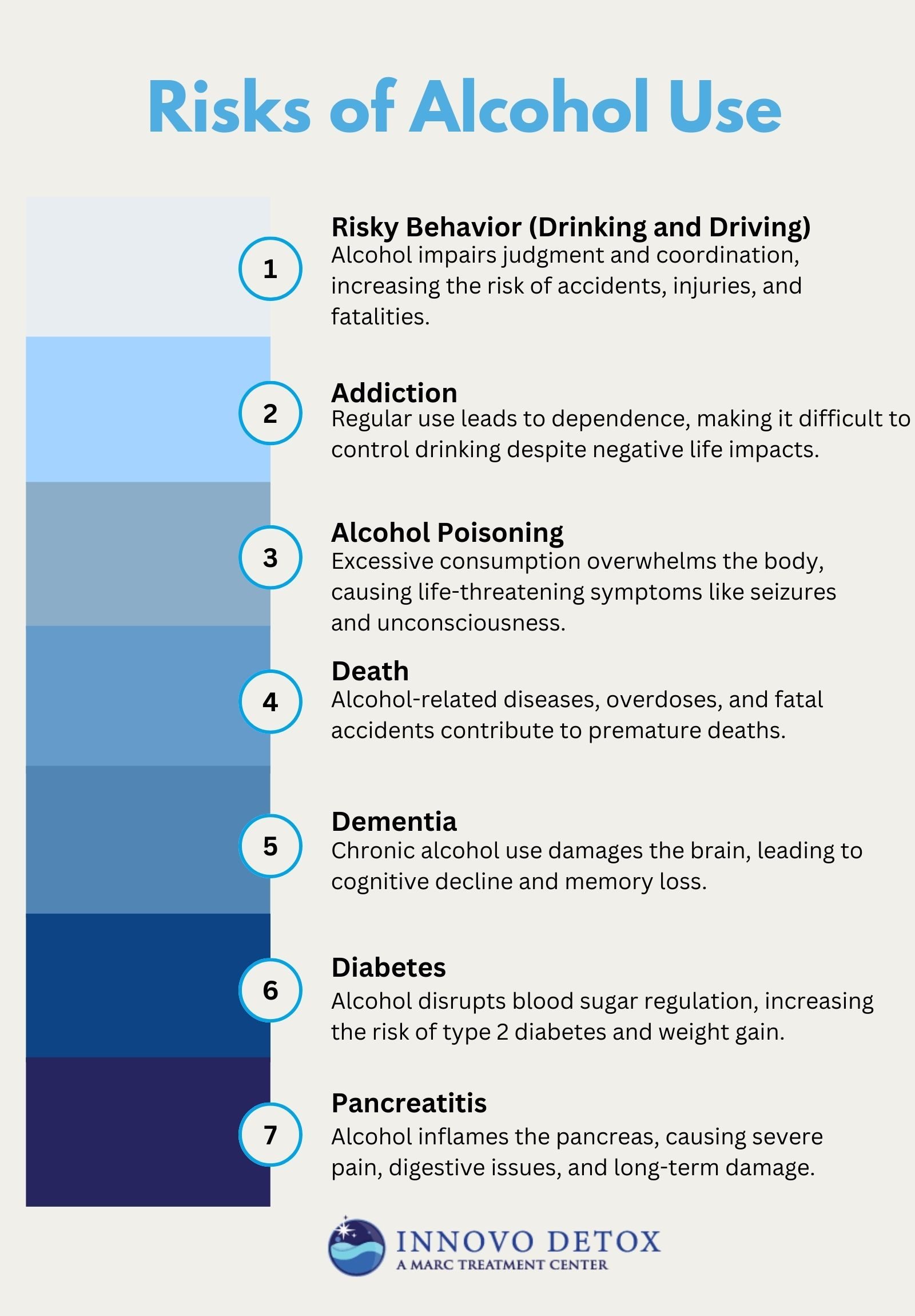
The risks of alcohol use are explained below:
- Risky Behavior (drinking and driving): Alcohol impairs judgment and coordination, increasing the likelihood of engaging in dangerous activities such as drinking and driving. This significantly raises the risk of car accidents, injuries, and fatalities, endangering both the drinker and others on the road.
- Addiction: Regular alcohol use leads to dependence, where individuals develop a physical and psychological reliance on alcohol. This results in alcohol use disorder (AUD), making it challenging to control drinking despite negative consequences on health, relationships, and responsibilities.
- Alcohol Poisoning: Consuming large quantities of alcohol in a short period overwhelms the body’s ability to metabolize it, leading to alcohol poisoning.
- Death: Excessive alcohol consumption is a major contributor to premature deaths, whether through alcohol-related diseases, fatal accidents, or overdose. Long-term heavy drinking leads to deadly conditions like liver failure, heart disease, and alcohol-induced brain damage.
- Dementia: Chronic alcohol use damages brain cells, leading to cognitive impairment and an increased risk of alcohol-related dementia. It accelerates memory loss, reduces problem-solving abilities, and contributes to conditions such as Wernicke-Korsakoff syndrome, a severe brain disorder caused by thiamine deficiency.
- Diabetes: Alcohol affects blood sugar levels and contributes to insulin resistance, increasing the risk of developing type 2 diabetes. Heavy drinking also leads to weight gain and pancreatitis, both of which are risk factors for diabetes.
- Pancreatitis: Alcohol consumption causes inflammation of the pancreas, a condition known as pancreatitis. Chronic pancreatitis results in permanent damage, affecting the body’s ability to process nutrients and regulate blood sugar.
What Is Alcohol Addiction?
Alcohol addiction, clinically known as Alcohol Use Disorder (AUD), is a chronic condition characterized by an inability to control or stop alcohol consumption despite adverse personal, professional, or social consequences.
In Pennsylvania, excessive alcohol use results in an annual average of 4,933 deaths, underscoring the severity of this issue in the state, according to the Centers for Disease Control and Prevention.
Alcohol’s addictive potential stems from its profound impact on brain chemistry. Consumption leads to increased dopamine release, a neurotransmitter associated with pleasure and reward, reinforcing the desire to drink.
Chronic use alters neural pathways, making cessation difficult and perpetuating dependence. Genetic predispositions and psychological factors, such as stress or trauma, further increase the risk of developing alcohol addiction.
How Is Alcohol Controlled in Pennsylvania?
In Pennsylvania, alcohol is controlled by the Pennsylvania Liquor Control Board (PLCB), which oversees the sale and distribution of alcoholic beverages through a state-run system.
The PLCB enforces a quota system for alcohol licenses—typically one per 3,000 residents—and recent laws, such as Act 39 of 2016, have expanded access by allowing wine sales in grocery stores and direct wine shipments to consumers.
According to the Pennsylvania Liquor Control Board’s 2023 Annual Report, these regulations aim to balance public access with responsible distribution and enforcement.
What Is Alcohol Addiction Treatment?
Alcohol addiction treatment includes detox, behavioral therapy, medically assisted treatment, and support groups, all aimed at helping individuals manage alcohol addiction and achieve long-term recovery. Each treatment approach addresses different aspects of addiction, ensuring a comprehensive recovery process.
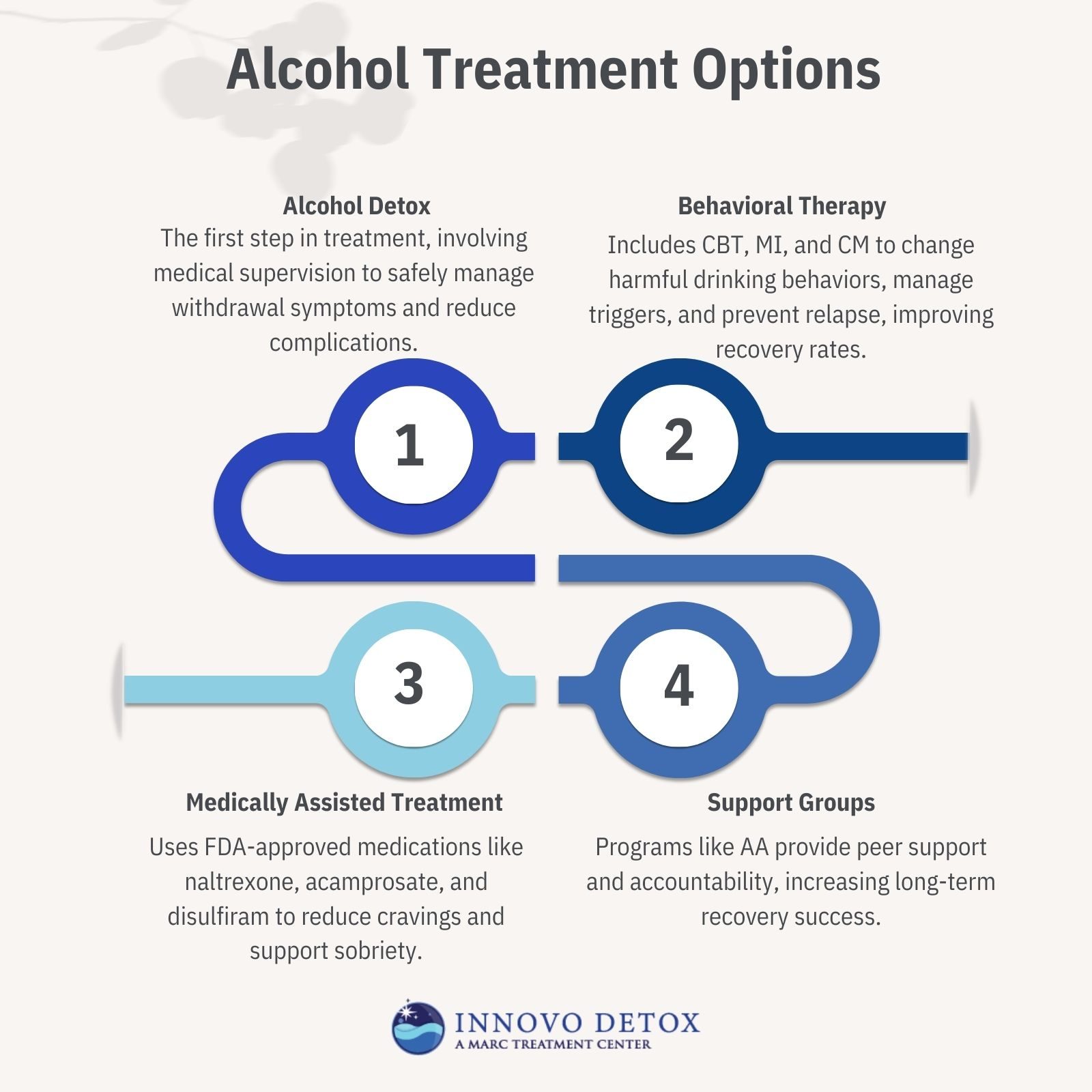
The alcohol addiction treatment is explained below:
Alcohol Detox
Alcohol detox is the initial step in treatment, focusing on safely removing alcohol from the body while managing withdrawal symptoms under medical supervision. Withdrawal causes severe symptoms, including seizures, delirium tremens (DTs), and extreme agitation, making medical detox important for safety. Medically supervised detox significantly reduces complications and improves the likelihood of continuing treatment.
Behavioral Therapy
Behavioral therapy helps individuals change harmful drinking behaviors and develop coping strategies to prevent relapse. Effective therapies for alcohol addiction include Cognitive Behavioral Therapy (CBT), Motivational Interviewing (MI), and Contingency Management (CM). Research has shown that CBT, in particular, helps individuals identify triggers and develop healthier responses, improving long-term recovery rates.
Medically Assisted Treatment
Medically assisted treatment (MAT) involves the use of FDA-approved medications to reduce cravings and prevent relapse. Common medications for alcohol addiction include naltrexone, which blocks the pleasurable effects of alcohol, and acamprosate, which helps restore brain chemistry. And disulfiram, which creates unpleasant reactions to alcohol consumption.
Support Groups
Support groups offer a community-based recovery approach, offering emotional and peer support. Alcoholics Anonymous (AA) is one of the most well-known support groups, following a 12-step program that encourages accountability, personal growth, and sobriety. Studies suggest that individuals who regularly attend AA meetings are more likely to maintain long-term recovery compared to those who do not engage in peer support.
How Much Alcohol is Considered a Moderate Amount?
Up to 1 drink per day for women and up to 2 drinks per day for men is considered moderate alcohol consumption, according to the Centers for Disease Control and Prevention (CDC).
Moderate drinking is based on standard drink measurements: 14 grams (0.6 ounces) of pure alcohol, which equates to 12 ounces of beer (5% alcohol), 5 ounces of wine (12% alcohol), or 1.5 ounces of distilled spirits (40% alcohol).
What Is Binge Drinking?
Binge drinking is the consumption of a large amount of alcohol in a short period, leading to a blood alcohol concentration (BAC) of 0.08% or higher. According to the National Center for Drug Abuse Statistics (NCDAS), 18.5% of Pennsylvania adults over 18 engage in binge drinking at least once per month.
What is Alcohol Withdrawal?
Alcohol withdrawal is a set of physical and psychological symptoms that occur when a person who is dependent on alcohol suddenly stops drinking or significantly reduces their intake. These symptoms escalate quickly and require medical supervision in severe cases
The withdrawal timeline follows a pattern: mild symptoms begin within 6-12 hours, peak withdrawal effects occur around 24 to 48 hours, and severe cases last up to a week or longer. The severity depends on factors like the individual’s drinking history, overall health, and whether medical intervention is provided.
Can You Overdose on Alcohol?
Yes, you can overdose on alcohol. It is a condition known as alcohol poisoning, which occurs when excessive alcohol consumption leads to dangerously high blood alcohol concentration (BAC).
Alcohol overdose symptoms include confusion, vomiting, seizures, slow breathing, and unconsciousness. According to the Centers for Disease Control and Prevention (CDC), Pennsylvania’s alcohol poisoning death rate stands at 6.5 per 1 million people.




